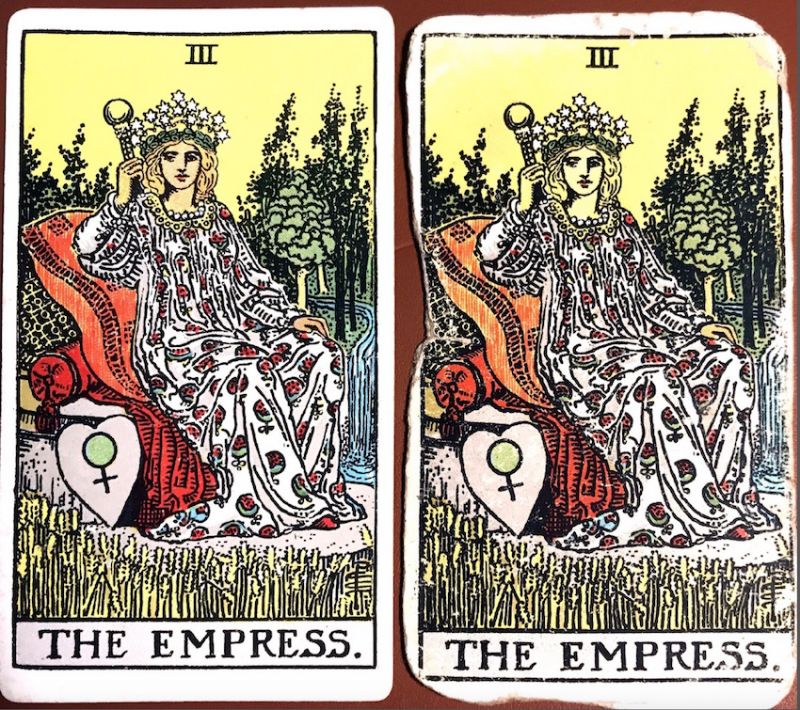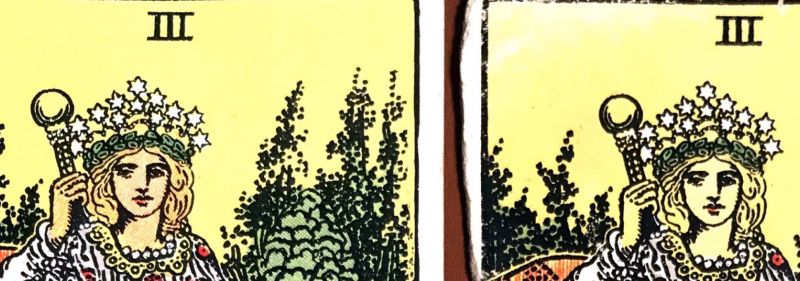 |
| Posted: Sun Oct 20th, 2019 12:00 pm |
|
1st Post |
Peter
Member

|
I'm fascinated by the early printings of the Rider Waite Smith decks, but still don't really know much about the number of printings for the A, B, C, and D versions.
I have two "Pam A" decks, 1) one only has the majors and the four kings, the other 2) a full deck, but so tattered and battered that few would want it. It would be impossible to use as a deck as quite a few card backs have separated, many cards are floppy, and all are worn and chipped.
I'm attaching two images so that you can compare cards from the two decks.
The first is the Emperor, which seems to lack the usual Pam A style shading on rocks in the left of the image. His face is also paler in the right-hand image.Attached Image (viewed 67 times):
 Last edited on Sun Oct 20th, 2019 12:15 pm by Peter
|
|
|
| Posted: Sun Oct 20th, 2019 12:10 pm |
|
2nd Post |
Peter
Member

|
The second image is the Empress. In the right-hand card you'll find the expected Pam A hatching-shading on her left hand (on the right of the picture), but her face and her other hand lack the shading.
I've seen modern versions with this but was surprised to find it in a Pam A. I really would be interested to hear your thoughts about this. I've had a look at high-quality scans of Pam A decks that are available online, but haven't noticed this variant. Of course, it may simply be that this is what happens with 'used and abused' decks, plus my lack of familiarity with enough early decks, but I thought that I'd share the images and ask for opinions.Attached Image (viewed 67 times):

|
|
|
| Posted: Sun Oct 20th, 2019 12:13 pm |
|
3rd Post |
Peter
Member

|
Ugh! Sorry about the image quality. I had to reduce the file-size and, of course, lost detail. Here is a close up of her face. Attached Image (viewed 68 times):

|
|
|
| Posted: Sat Oct 26th, 2019 06:23 pm |
|
4th Post |
OnePotato
Member

| Joined: | Sun Sep 9th, 2007 |
| Location: | USA |
| Posts: | 325 |
| Status: |
Offline
|

|
Hi Peter.
Hard to say what's going on here.
With just the photos to go on, it's impossible to judge the effects of wear & tear on the right hand deck, versus variations in the print qualities.
But....
Early stone-based lithography is very different from modern automated offset litho printing from plates.
Printing from stone involves a lot of hand work, and as a result, it is not at all consistent.
The basic idea is that the image area is greasy, and grabs the ink as it is rolled on the stone with a rubber roller, and the clear background areas are porous stone that holds water which repels the oil in the ink so that it doesn't transfer from the roller. Once the ink is on the greasy parts of the stone surface, the paper is placed on it & it's run through the press under tremendous pressure, so that the ink transfers onto the paper. And this process is repeated separately for each color of ink. As you can imagine, all of this is a pretty delicate balancing act, over the course of many, many repetitions over a period of time.
Variations in the amount of ink on the roller, density of the ink, the tack (stickiness) of the ink, the amount of moisture on the stone, the temperature & humidity in the air, the pressure of the press, and any number of other factors all contribute to the final image quality. Some of these effects are very subtle, or nearly imperceptible, but sometimes they will add up & become visible, or sometimes they will take a sudden drastic turn for a few prints before settling back to consistent ink coverage.
What I see here looks like skipping in the red plate, where it has printed too light overall & is all but invisible in some areas. So a variation like this is not necessarily due to there being two entirely different 'printings" (editions), but may be a portion (of unknown quantity) of the run where the red was not fully covering. It could be a "progressive" problem, where there are other copies that are less severe, but get worse as it dried out little by little, or it could be a one-off, where something went bad & was immediately corrected on the next copy.
This sort of thing happens all the time in various forms of hand printing, like etching & woodcut & litho. It's an expected part of the process, so you typically print 10% over the desired quantity. One of the things a good printmaker does is judge the print quality of every image, and only release those that are deemed acceptable. Little flaws and variations in the image are acceptable, and a big part of the charm, but when they get too noticeable, they belong in the scrap pile. (This is how a lot of very early playing card images survived: uncut rejected sheets were used as stiffeners inside book covers.)
Anyway, as I said, I can't be sure, but this is probably a pretty good guess. These days I mostly stay out of the ongoing discussion about early "Pam" editions but I appreciate seeing this and it looks like you're not getting any other bites...

Last edited on Sat Oct 26th, 2019 06:29 pm by OnePotato
|
|
|
| Posted: Sun Oct 27th, 2019 12:16 pm |
|
5th Post |
Peter
Member

|
Hi OnePotato,
Thanks for the helpful reply. It must have been incredibly time-consuming to print a full deck! Do you know if there's any information about the standard number of decks printed for an edition?
On a practical level, do you think they would have printed multiple copies of a single card with one colour and then added the extra colours to all those copies, or would they have worked literally on one card at a time? Sorry if this sounds a bit dumb, but I'm trying to imagine the production process.
Do you think that the lithographic stone used would just hold the image of a single card or would it have, for example, all the major arcana?
You mention a 'red plate'. Does that mean there are multiple stones for each card, each adding different details in different inks, with the cross-hatching (on the Empress) added later, obviously, than the lemony yellow colour for her face?
Oh, another question: is there any sequence for the addition of colours? Do you start with light tones and add progressively dark, or the other way round? Just curious :)
Thanks for such interesting information!
All best,
Pete Last edited on Mon Oct 28th, 2019 10:21 pm by Peter
|
|
|
| Posted: Mon Nov 4th, 2019 05:13 pm |
|
6th Post |
OnePotato
Member

| Joined: | Sun Sep 9th, 2007 |
| Location: | USA |
| Posts: | 325 |
| Status: |
Offline
|

|
Hi Peter.
I do not know how many copies they printed for each of the known editions. Probably a few thousand. It was a much slower process than modern printing, but it was somewhat mechanized, and probably faster than you are envisioning....
Large stones were easily available back then, and they would almost certainly have done the entire deck ganged up on a single large stone, on a large sheet of paper. These days, as I understand it, the German limestone quarry that supplied all of the stones for lithography throughout the years has closed, so all we have to work with is what we have. Stones break, (Usually from the extreme pressure of the press. In my experience, the breaks happen very suddenly, and dramatically, with a big POP! I've never heard of a slow crack developing and spreading across a stone over time.) and they get discarded, or continue on as smaller stones if the fragments are big enough to still use. The bigger ones break more often, because it's harder to keep the pressure evenly distributed. Since the supply is finite, as the years go by, we end up with fewer big ones, and more smaller ones. Given this problem, we now have alternatives to traditional stone, including specially developed metal plates that behave similarly to stone.
When printing from stone:
- You would have a separate stone for each separate color.
- Each color is printed on a separate pass through the press.
- You would print all copies of a given color, before moving on to the next color.
- You could have as many colors of ink as you like, but each requires a stone and a separate pass, so the more colors you have, the more time & work it would take to complete your job. This fact lead to the development of a number of techniques that could create the appearance of more color variations, without using separate inks. Hatching, cross-hatching, or stippling, could all produce an "optical mixing" effect. Some degree of transparency in the inks could also produce color variation by overprinting one color over another. The sequence of the colors does matter, but it depends on what specific colors are used, and how the particular pigments behave. These kinds of technical abilities varied from individual printer to printer, as you can see when you compare the various Pamela deck versions.
- Litho stones are re-useable by nature. Step one of the printing process is to re-surface the stone by grinding it down with abrasives, thus erasing the previous image and creating a fresh, clean surface to work on. This is probably why we don't have the original stones from any Pamela decks: They COULD have been put aside and saved, or they could just as easily have been turned into theater posters, or fashion catalogs, or any number of more mundane printed things….
|
|
|
| Posted: Fri Nov 8th, 2019 12:35 pm |
|
7th Post |
Peter
Member

|
Thanks for such an informative reply. I really do enjoy learning more about printing and wish I had time (and talent) to get practical experience.
|
|
|
| Posted: Thu Nov 14th, 2019 05:09 pm |
|
8th Post |
OnePotato
Member

| Joined: | Sun Sep 9th, 2007 |
| Location: | USA |
| Posts: | 325 |
| Status: |
Offline
|

|
Peter wrote: Thanks for such an informative reply. I really do enjoy learning more about printing and wish I had time (and talent) to get practical experience.
Ya, there's not so many people studying the ancient esoteric lore of the printing arts these days. The digital zombies have all but eradicated us.
|
|
|

Current time is 05:36 pm | |
|
 |
|

